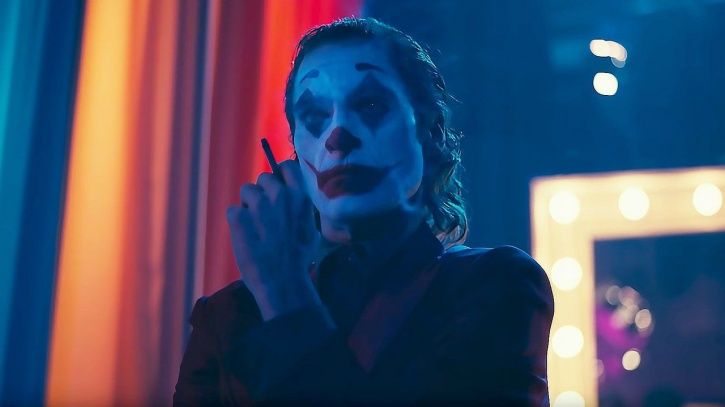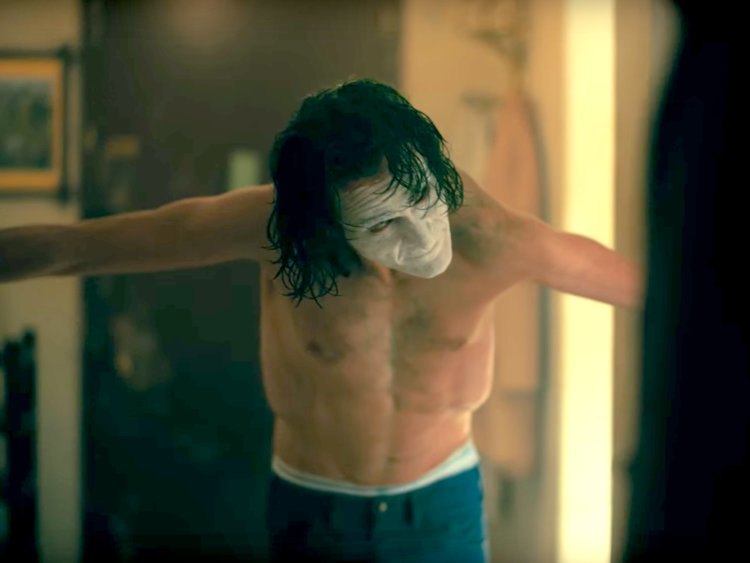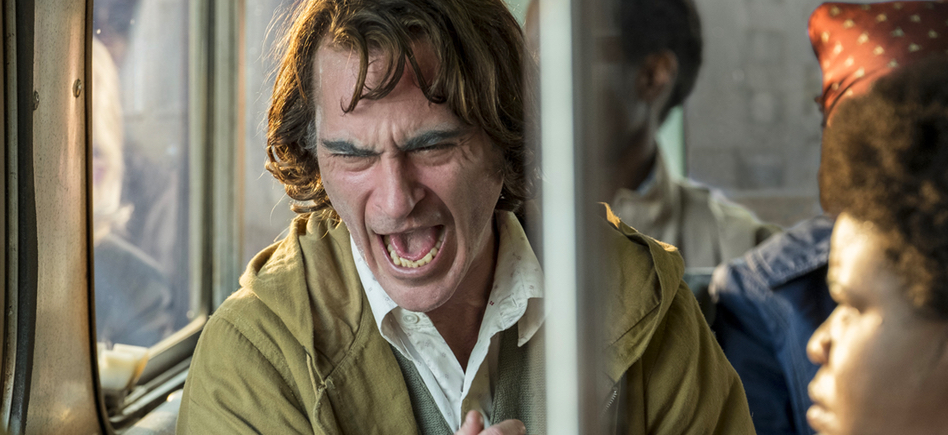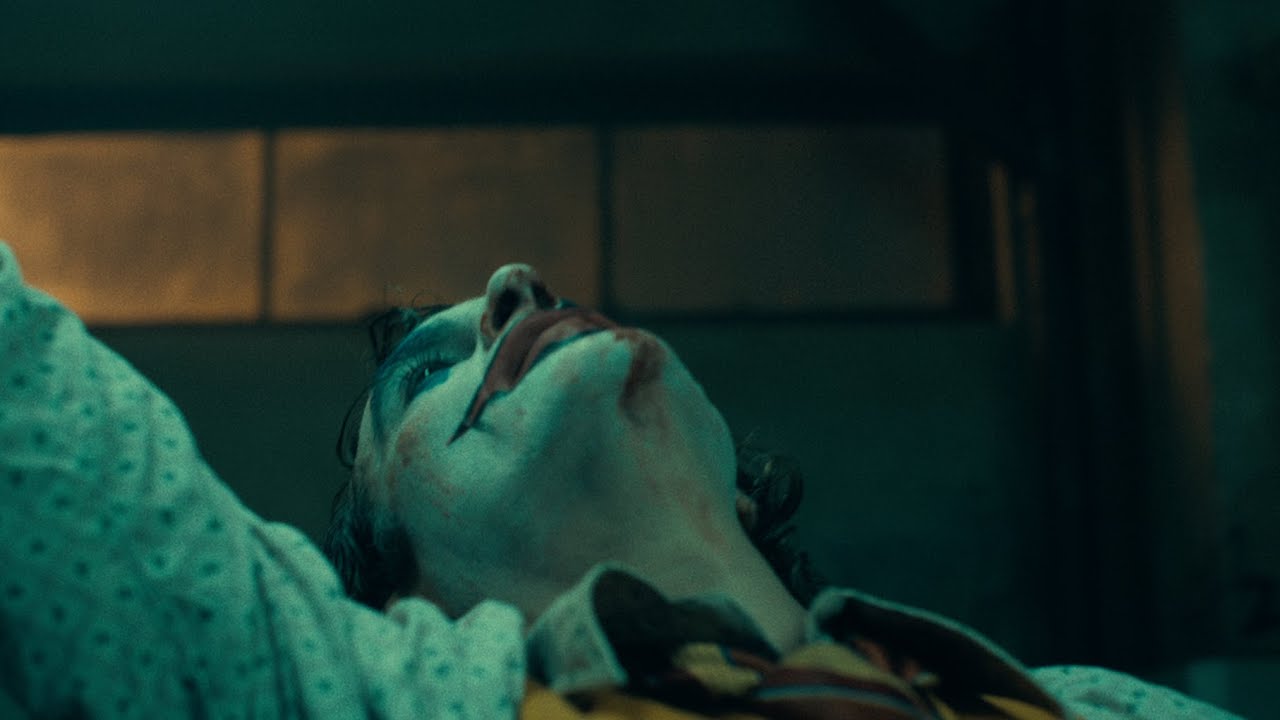There is a scene in the film nearly at the quarter mark wherein Arthur Fleck, a failed comedian in Gotham City trying to make his living by working for a clown-for-hire company, believing so that his purpose was to bring joy and laughter to people’s lives, is travelling back home in a Gotham city bus after being told that he was going to be off his medications since the state cut funding to the free help centre that he visited. His face propped up against the window, and still partially covered in the face paint that he donned earlier, as if a side of him ominously there, always, and refusing to let go. He simply looks at a morose child sitting in front of him and tries to get him to smile by making silly faces, all in good spirit, supposedly, until the mother lashes out at Arthur for bothering her child, making him inadvertently burst into a fit of nervous, melancholic laughter owing to his neurotic condition, handed out to the lady in a neatly laminated piece of paper. The scene pans out with the rest of the passengers going by unperturbed, while Fleck, uncharacteristically the only lone passenger on the bus, continues laughing over his own misery.
If I were to choose one scenario to encapsulate the point that ‘Joker’ was trying to make, it would be this one. It’s easy to see that Arthur isn’t the villain here, but it isn’t too difficult to understand why the lady wasn’t completely wrong either of her distrust of a stranger in a city torn apart by crime and hate. This is the moral ambiguity that ‘Joker’, a retelling of the origins of the iconic DC villain of the same name brings to the fore, and toys with, often in devilishly twisted ways, and often in deeply painful realities reflected in your face.
Are criminals born, or are they made? You might find yourself posing this question to yourself one too many times during this film, as is the age-old rhetoric. I must tell you that there are no clear answers here, but if you are willing to take this journey into the dark corners of Fleck’s mind, you may just come out a person who is in a better position to be posed that question to.
The Ending, Explained

The film does bear the semblance of a three point narrative arc, but ultimately doesn’t stick by it too much since firstly, there is no villain here, except for the cesspool of ignorance that ‘modern’ society is shown to be. And secondly, almost every part of it is so deeply affecting that even when the film finally wraps up in the deafening crescendo of a burning Gotham city, literally up in flames, you appreciate the character, however horrific, being carefully developed through several broken pieces rather than three portions of story.
A testament to this is the film beginning with overlapping chatter of news about the downfall of the city, infested with rats, plague, poverty and unemployment, panning to a desolate Arthur in front of the dressing table, his face covered in the joker make-up but flowing off from his painfully held back tears. He forces himself to smile, until he can’t anymore. For all you know, this is a scene that could be placed anywhere in the film, and it would work. I will have you know that this then isn’t a traceable descent into madness. Arthur Fleck is already hanging by a thread when the film opens, and instead of “one bad day”, it is a sequence of maddening events that gradually lead to the thread being gnawed off.
As for the ending itself, we dial our clocks a little backward into the clutches of chaos when Fleck finally assumes the persona of the Joker, delightfully breaking into dance at the steps near his residence when he is fiercely pursued by the two detectives who suspect Arthur in relation to the subway murders. He attempts to escape and boards a train full of protestors inspired by the clown, a cult-like movement that Arthur sparked off after his face was caught in make-up while escaping from the station after shooting those three men. It’s easy for him to get lost in that crowd, while all hell breaks loose as the detectives end up engaging and shooting a protestor, while the others surround them to take them down, allowing Arthur to escape.
I would like to digress here to elucidate upon the point of that cult that the Joker inspired from his actions, more than Thomas Wayne’s words. The mask here of course was a symbol that united the very underbelly of Gotham, the have-nots against the haves. However, apart from lending anonymity, the cult finds the mask enabled them to be no-one, just like Arthur. Through some perverse way, it gave them all a sense of belonging in their suffering and oppression, since it was also plenty clear that Arthur intended no part of the “movement”, nor had anything to do with the politics of it all.

He reaches the sets of the Murray Franklin show where he is supposed to make an appearance, and asks his host to introduce him as Joker when he came out. In his signature twisted style, he makes quite an entrance but quickly calls Murray out on his supposed insensitivity, playing clips of his failed comedy show on air and inviting him over to ridicule him. He confesses to the murder of the three men, and as the argument between Murray and him gets tense, he ends up shooting Murray in the face, citing that he got “what he f**king deserved” for ridiculing a man living in isolation and neglect. His actions on the show elevate his status from the initiator of the movement to a messiah of the downtrodden masses of Gotham, who rescue him when he is arrested, placing him on a literal pedestal, atop a police car, hailing him for his actions.
At this moment, the Joker truly comes into his own, while Arthur finally finds a sense of belonging, finds something that he wanted all along: an audience and someone who would just, listen. You lie if literal chills didn’t run through your body when he takes the blood flowing out of his nose and paints his “scarred” smile across his face.
The scene then cuts to black and opens with Fleck caught up in a mental institution, being questioned by another psychiatrist. He laughs and laughs, at this point indistinguishable whether it’s from his condition or from his alter ego that he had developed. Characteristically so, the doctor asks if he thought any of it was funny, at which he shares that he does have a joke but won’t tell it, since the doctor wouldn’t get it.
This is an important turning point in my opinion, since here Arthur would seem to have completed his transformation into the clown, closing himself off to the outside world for good, seeing as though none of it was any help when he needed it, a scathing commentary on the foils of the modern society. Either that, or he simply sees a cruel, brutal joke in Bruce’s predicament with his parents shot dead in the alley by one of the Joker’s supporters, leaving him with no one in the world, just like the Joker: a quintessential play on the hero villain dynamic between the two, prying off on how either could have become either owing to their rather tragic origins, but keeps the joke to himself simply deeming the doctor not informed enough to understand what he thought was funny in that. Moments later, he emerges from the room, still handcuffed with bloody feet, slowly walking into the corridor, breaking into dance and being pursued by the prison guard as the film closes and the legend of the Joker is born.
The Batman Connection
A hero is only as good as the villain, and this is something widely accepted in the comic book fandom. Except, its opposite may not be entirely true, and this film stands as living proof of that. However, ‘Joker’, while mostly working on the solo front, does make an effort to establish the villain as part of a larger universe, even if of its hero alone. As the city descends into madness around him and the Joker stands up to assume his mantle, in another part of the city, the legend of Bruce Wayne is taking shape, as the Wayne family rushes out of a ‘Zorro’ screening at the theatre, akin to the comics, while moments later, they are shot dead in cold blood by one of the Joker cult supporters, citing the same thing that Joker did while shooting Murray Franklin. He got “what he f**king deserved”.
An earlier connection with the Waynes is observed when Arthur confronts Thomas Wayne, believing him to be his father as revealed by his ailing mother. Thomas strikes Arthur down angrily stating that his mother was delusional, leading Arthur to discover that he was adopted and abandoned by his mother multiple times before having a history of abuse by her earlier boyfriends, further pushing him down into the abyss.
I wouldn’t call these easter eggs as much as I would call them universe call backs, helping an otherwise isolated story of psychiatric and societal neglect and one person’s descent into darkness find its footing in an otherwise rich mythology. In that, the Joker’s little meetup with the young, unassuming Bruce Wayne is just a delightful tease. The joker, pulling boy Bruce’s cheeks to form a smile is the stuff of Joker’s fun-land dreams.
Was It All His Imagination?

Now this is an interesting hypothesis. Surely, while watching this nightmarishly psychological take on the Joker’s state of mind, you would have been hit with the question. What if he merely thought all that up? Arthur Fleck clearly was delusional, having made up several scenarios in his head, including him going out with his neighbour Sophie Dumond and having a grand reception at his comic shows, while none of that actually transpires. To what extent then, does Arthur’s delusion go? Where does he stop?
While the ending with him standing on top of a car and finally having an audience cheering for him, something that he had always wanted as a wish seeking fulfillment, there is the brief possibility of him turning to seeking an audience from a different faction altogether, seeing as though reality turned out to be quite different when he imagined otherwise. When in his broken fantasy, he fails to charm the white collars and blue bloods of Gotham through his comic acts, it is entirely possible that he turned his attention to the “unwanted” faction of Gotham, swaying them through his radical acts of crime.
The final segment of the film occurring after the blackout, wherein Arthur meets with the psychiatrist in a mental institution, would then be the place where he wound up after his diagnosis, foregoing all of what transpired, limiting them only to his fertile, yet dangerous imagination. This is something that I feel would be up for debate for months after the film is off theatres, since unlike a film like ‘American Psycho’, there aren’t enough tangible proofs to commit to either theory.
Final Word

‘Joker’ is hardly a comic book movie. In fact, it is its complete antithesis, wherein there is no semblance of a hero, and the villain assumes centre-stage. In fact, as stated in our review from TIFF, it is the closest thing to ‘Taxi Driver’ set in 2019. Likewise, director Todd Phillips wants the film to have an unmistakably retro vibe that goes beyond the props and the cars. Everything from the opening and closing titles to the choice of songs, terrific by the way, accompanying the sometimes horrifying scenes, spot on scream 80s American metropolis. Yet still, ‘Joker’ works because it’s almost timeless.
Gotham is no city, and in acute subversion, every city in the world. Arthur Fleck too is no one, but he could be anyone and everyone: a person walking on the street or riding the subway with you or even working with you. THAT is what makes it real, and that’s what makes it terrifying. Phillips deserves due credit here, whose presentation of an “origin story” for the villain essentially works towards humanising the clown prince of crime, even if a deeply flawed albeit disturbed one, beyond the associated menace and chaos.
And then of course, there is Joaquin Phoenix, a man who has been known to alleviate even mediocre films through his act. Given the film that ‘Joker’ is, the two complement each other to give us a golden product. His performance is brilliant through and through, but there are moments when Phoenix is left alone with the camera, in his apartment or in front of the mirror, and that’s when he takes his muse to town, really showing what a pool of talent the man is: in vulnerability, in anguish, or even in comedy.
A lot of the onus of Philip’s intention to blur the line between all the “wrong” that Fleck does throughout his journey, and to cast the image of the iconic villain as a victim of circumstance rather than a mindless mass killer, rested on Phoenix. In the hands of a lesser actor, it could have been easily undone. Thankfully, here is a performance with no false notes. Phoenix’s performance will make you not only root for the “bad guy” here, but would want to wish him a hearty farewell and a happy ever after. That’s how powerful he is. At this point, I am supposed to be closing out with a joke or a jest, but, you wouldn’t get it. A killing joke and a knockout of a film, this one might have you reeling from it days after.
Read More in Explainers: Midsommar | John Wick 3



